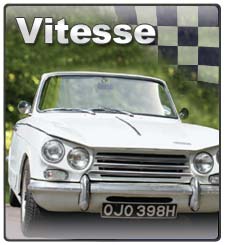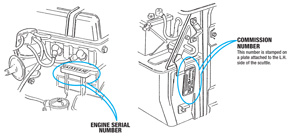Triumph Vitesse Vehicle Information

Like the Spitfire which closely followed the introduction of the Herald, the Vitesse 1600 nearly didn’t come into being. It was only down to the backing of Leyland Motors, the new owners of Standard-Triumph. They had started to develop a six cylinder Herald, but due to the financial restrictions in 1960/61, the money was not available to take it to fruition.
With the ease that people now transplant six cylinder engines into Heralds, you would have thought that it was an easy and logical step to develop the Vitesse from the Herald. However it was not as simple as it might seem. Not only did the designers have to find room for the extra length of the six cylinder engine, but the gearbox and the back axle were woefully inadequate to handle the extra torque and power that the new model would provide. By 1961 most of the technical problems had been solved and Atom, as the project was code named, was well under way. At a board meeting, the Atom project was added to the plans for introduction in 1961/62 with upwards of 3,500 cars to be made in the first year and 8,500 cars in the following year. Due to having to develop the new car as quickly and as cheaply as possible, the proposal to restyle the rear of the car was dropped, and from the rear, the Atom was very little different from the Herald. It was hoped to have the car ready for the 1961 Earls Court Motor Show however, the new car which came to be called Vitesse was finally launched in May 1962.
Due to the need to strengthen up the chassis from what we now refer to as the MK1 chassis used by the early Heralds, it was decided to incorporate the Vitesse improvements that would then be used throughout the Vitesse and Herald models from there on. The first Vitesse models used the newly launched six cylinder 1,596cc /70bhp engine derived from the Vanguard Six 2 litre power unit. This was physically the same size as the 2 litre unit and caused a few problems trying to get everything under the bonnet. The designers achieved this by pushing the radiator further forward and the use of a remote header tank which ran parallel to the engine block. The first cars were fitted with downdraught Solex carburettors. The latter 1600cc cars had Stromberg CD150 side draught carburettors.
When launched, it was priced at £837 for the saloon and £893 for the convertible although there were some different touches from the Herald, like the quad headlamps, aluminium bumpers and a larger fuel tank. It was soon obvious that it was built to a price, as the dash was virtually identical to that found in the 1200 Herald.
Due to poor press reports on both sides of the Atlantic in September 1963, Triumph made some much needed improvements to the Vitesse. The dashboard was now equipped with matching speedometer and rev counter along with separate fuel and water temperature gauges. As British purchase tax had just been reduced, the new improved 1600 Vitesse was actually cheaper than the original model.
By the end of summer 1966, a very different and faster Vitesse would take over from the 1600 model. Even in 1963 it did not take much imagination to see that a 2 Litre engine could be fitted into the Vitesse, but it took 3 years before this much anticipated modification came to fruition.
Most of the modifications were hidden away under the bodywork, the new car would gain an improved differential, a new type of gearbox, larger front brakes and of course a 2 Litre engine.
Due to a well thought out launch date, (the same day as the brand new GT6!) the ‘new’ Vitesse did not get much press coverage. However the car was substantially faster and produced more torque than the outgoing model. Unfortunately nothing was done to the rear suspension and this facet of the design was again picked upon as it was in the newly launched GT6. So in the autumn of 1968, the MK2 and last incarnation of the Vitesse was launched. The new rear suspension was a clever design and silenced the criticism that had been directed at the old set up. All throughout the life of the Vitesse it had only been officially offered in Saloon and convertible options, although there were a few dealer produced estate conversions. The last Vitesse came of the production line in May 1971 with a total of 51,232 built.
Vehicle Production & Specification Summary
| Model |
Production Dates |
Total Built |
Commission Numbers |
| Vitesse 1600 Saloon |
May 1962 to September 1966 |
22814 |
HB4DL to HB34053 |
| Vitesse 1600 Convertible |
May 1962 to September 1966 |
8447 |
B47CV to HB34053 |
| Vitesse 2 Litre MK1 Saloon |
September 1966 to September 1968 |
7328 |
HC6 to HC12079 |
| Vitesse 2 Litre MK1 Convertible |
September 1966 to September 1968 |
3502 |
HC6 to HC12079 |
| Vitesse 2 Litre MK2 Saloon |
July 1968 to July 1971 |
5649 |
HC50001DL to HC57996DL |
| Vitesse 2 Litre MK2 Convertible |
July 1968 to July 1971 |
3472 |
HC50006CV to HC58109CV |
| Model Suffix Letters |
| Model Type |
Suffix Letters |
| Saloon |
DL |
| Convertible |
CV |
| Overdrive |
O |
| Sun Roof (Factory) |
RS |
| Left Hand Drive |
L |
| Capacities |
| Fuel |
|
8 3/4 Gallons (40 litres)
|
| Oil |
Engine |
8 Pints (4.7 litres) |
| |
Gearbox |
1 1/2 Pints (0.9 litres) |
| |
Rear Axle |
1 Pint (0.6 litres) |
| |
Cooling |
11 Pints (6.25 litres) |
Engine & Commission Number Locations

These illustrations show where to locate the Engine number and the Body Commission number on the Triumph Vitesse.